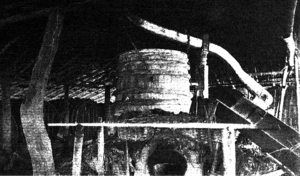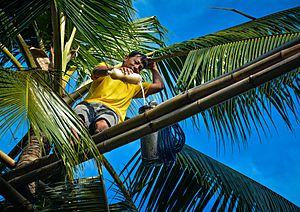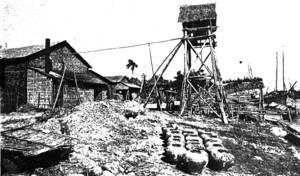Lambanog facts for kids
| Type | Palm liquor |
|---|---|
| Country of origin | Philippines |
| Region of origin | Luzon, Visayas |
| Alcohol by volume | 40–45% |
| Ingredients | Coconut sap |
Lambanóg is a special Filipino drink made from coconut sap. It is a type of palm liquor that has been distilled, meaning it goes through a process to make it stronger. This drink comes from the Philippines, especially the islands of Luzon and the Visayas.
People sometimes call lambanóg "coconut vodka" because it is clear or milky white and has a lot of alcohol. It usually contains about 40% to 45% alcohol. Its smooth taste has been compared to Japanese sake or European schnapps. A similar drink, called laksoy, is made from nipa palm sap instead of coconut.
What is Lambanóg?

Lambanóg is known for having a lot of alcohol, typically 40% to 45%. This is much stronger than other palm wines like bahalina (10%-13% alcohol) or tubâ (2%-4% alcohol).
Most people drink lambanóg plain. However, it can also be flavored. Traditionally, it was sometimes flavored with raisins. Today, you can find modern lambanóg with many different flavors, like mango, blueberry, pineapple, bubblegum, and cinnamon. These new flavors help make the drink popular with more people.
How Lambanóg is Made

Making lambanóg has a long history in the Southern Tagalog region of the Philippines. The main areas where it is produced today are the provinces of Quezon, Laguna, and Batangas. These places have many coconut farms, which are important for making the drink.
Most lambanóg producers are small, local businesses. They often have only a few employees, usually between 4 and 25 people. Quezon province is the biggest producer of lambanóg. It is home to the three largest lambanóg makers in the country: Mallari Distillery, Buncayo Distillery, and Capistrano Distillery. During the Spanish colonial period of the Philippines, lambanóg was also made in the Visayas Islands.
Safety and Regulations
To keep people safe, the Food and Drug Administration (FDA) and the Department of Agriculture in the Philippines have rules for making lambanóg. It is against the law to produce lambanóg without being registered with these government groups.
It is very important for consumers to only buy lambanóg that is properly sealed and made by companies registered with the FDA. This helps make sure the drink is safe to consume.


